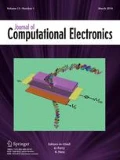Abstract
An attempt is made in this paper to study the influence of skin depth on the parasitic series resistance of millimeter-wave IMPATT devices based on Silicon. The method is based on the concept of depletion width modulation of the device under large-signal condition. A large-signal simulation model based on non-sinusoidal voltage excitation is used for this study. The electric field snap-shots of 35 GHz Single-Drift Region (SDR) and 94 GHz Double-Drift Region (DDR) IMPATT devices are first obtained from which the series resistances are estimated by incorporating the effect of skin depth in the modeling and simulation. The series resistances of these devices are also obtained by neglecting the effect of skin depth. The values of series resistances obtained from the simulation are compared with the corresponding experimentally reported values. It is observed that the series resistance estimated by including the skin effect is in closer agreement with the experimental values as compared to that without including the same. Thus the skin effect plays an important role for determining the series resistance of IMPATT devices at millimeter-wave frequency bands.














Similar content being viewed by others
References
Midford, T.A., Bernick, R.L.: Millimeter wave CW IMPATT diodes and oscillators. IEEE Trans. Microw. Theory Tech. 27(5), 483–492 (1979)
Chang, Y., Hellum, J.M., Paul, J.A., Weller, K.P.: Millimeter-wave IMPATT sources for communication applications. In: IEEE MTT-S International Microwave Symposium Digest, pp. 216–219 (1977)
Gray, W.W., Kikushima, L., Morentc, N.P., Wagner, R.J.: Applying IMPATT power sources to modern microwave systems. IEEE J. Solid-State Circuits 4(6), 409–413 (1969)
Acharyya, A., Banerjee, J.P.: Prospects of IMPATT devices based on wide bandgap semiconductors as potential terahertz sources. Appl. Nanosci. (2012). doi:10.1007/s13204-012-0172-y
Acharyya, A., Banerjee, S., Banerjee, J.P.: Optical control of millimeter-wave double-drift region silicon IMPATT device. Radioengineering 21(4), 1208–1217 (2012)
Acharyya, A., Banerjee, J.P.: Dependence of avalanche response time on photon flux incident on DDR silicon IMPATT devices. In: Proceedings of 32nd PIERS, Moscow, Russia, pp. 867–872 (2012)
Ray, U.C., Gupta, A.K.: Measurement of electrical series resistance of W-band Si IMPATT diode. In: Proceedings of 2nd Asia Pacific Microwave Conference Proceedings, China, pp. 434–437 (1988)
Misawa, T.: Multiple uniform layer approximation in analysis of negative resistance in p-n junction in breakdown. IEEE Trans. Electron Devices 14(12), 795–808 (1967)
Adlerstein, M.G., Holway, L.H., Chu, S.L.G.: Measurement of series resistance in IMPATT diodes. IEEE Trans. Electron Devices 30(2), 179–182 (1983)
Mitra, M., Das, M., Kar, S., Roy, S.K.: A study of the electrical series resistance of Si IMPATT diodes. IEEE Trans. Electron Devices 40(10), 1890–1893 (1993)
Pal, T.K.: Series resistance of silicon millimeter wave (Ka-band) IMPATT diodes. Def. Sci. J. 59(2), 189–193 (2009)
Luy, J.F., Casel, A., Behr, W., Kasper, E.: A 90-GHz double-drift IMPATT diode made with Si MBE. IEEE Trans. Electron Devices 34(5), 1084–1089 (1987)
Harth, W.: Large-signal series resistance of IMPATT-diodes. Arch. Elektron. Uebertragungstechnik 33, 502–504 (1979)
Acharyya, A., Banerjee, S., Banerjee, J.P.: A proposed simulation technique to study the series resistance and related millimeter-wave properties of Ka-band Si IMPATTs from the electric field snap-shots. Int. J. Microw. Wirel. Technol. 5(1), 91–100 (2013)
Acharyya, A., Banerjee, S., Banerjee, J.P.: Effect of junction temperature on the large-signal properties of a 94 GHz silicon based double-drift region impact avalanche transit time device. J. Semicond. 34(2), 024001 (2013)
Acharyya, A., Banerjee, S., Banerjee, J.P.: Large-signal simulation of 94 GHz pulsed DDR silicon IMPATTs including the temperature transient effect. Radioengineering 21(4), 1218–1225 (2012)
Acharyya, A., Banerjee, S., Banerjee, J.P.: Temperature transient effect on the large-signal properties and frequency chirping in pulsed silicon DDR IMPATTs at 94 GHz. In: Proceedings of IEEE Conference CODEC 2012, Kolkata, India, pp. 1–4 (2012)
Sze, S.M., Ryder, R.M.: Microwave avalanche diodes. Proc. IEEE 59(8), 1140–1154 (1971). Special Issue on Microwave Semiconductor Devices
Pal, T.K., Banerjee, J.P.: Design, fabrication and RF characterization of Ka-band silicon IMPATT diode. Int. J. Eng. Sci. Technol. 2, 4775–4790 (2010)
Grant, W.N.: Electron and hole ionization rates in epitaxial silicon. Solid-State Electron. 16, 1189–1203 (1973)
Canali, C., Ottaviani, G., Quaranta, A.A.: Drift velocity of electrons and holes and associated anisotropic effects in silicon. J. Phys. Chem. Solids 32, 1707 (1971)
Zeghbroeck, B.V.: Principles of Semiconductor Devices. Colorado Press, Denver (2011)
Electronic Archive: New semiconductor materials, characteristics and properties. http://www.ioffe.ru/SVA/NSM/Semicond/Si/index.html (2013). Accessed 11 January 2013
Hayt, W.: Engineering Electromagnetics, 4th edn. McGraw-Hill, New York (1981). ISBN 0-07-027395-2
Mass magnetic susceptibility of the elements. http://periodictable.com/Properties/A/MassMagneticSusceptibility.v.log.html (2013). Accessed 21 January 2013
Density of the elements. http://periodictable.com/Properties/A/Density.v.log.html (2013). Accessed 21 January 2013
Electrical conductivity of the elements. http://periodictable.com/Properties/A/ElectricalConductivity.v.log.html (2013). Accessed 21 January 2013
Padovani, F.A., Stratton, R.: Field and thermionic-field emission in Schottky barriers. Solid-State Electron. 9, 695–707 (1966)
Rhoderick, E.H., Williams, R.H.: Metal-Semiconductor Contacts, 2nd edn. Clarendon, Oxford (1988)
Andrews, J.M.: The role of the metal-semiconductor interface in silicon integrated circuit technology. J. Vac. Sci. Technol. 11, 972–984 (1974)
Sridharan, M., Roy, S.K.: Computer studies on the widening of the avalanche zone and decrease on efficiency in silicon X-band symmetrical DDR. Electron. Lett. 14, 635–637 (1978)
Sridharan, M., Roy, S.K.: Effect of mobile space charge on the small signal admittance of silicon DDR. Solid-State Electron. 23, 1001–1003 (1980)
Author information
Authors and Affiliations
Corresponding author
Rights and permissions
About this article
Cite this article
Acharyya, A., Banerjee, S. & Banerjee, J.P. Influence of skin effect on the series resistance of millimeter-wave IMPATT devices. J Comput Electron 12, 511–525 (2013). https://doi.org/10.1007/s10825-013-0470-y
Published:
Issue Date:
DOI: https://doi.org/10.1007/s10825-013-0470-y



